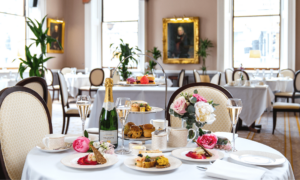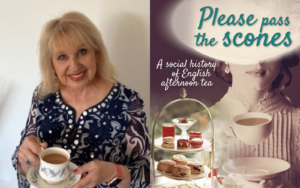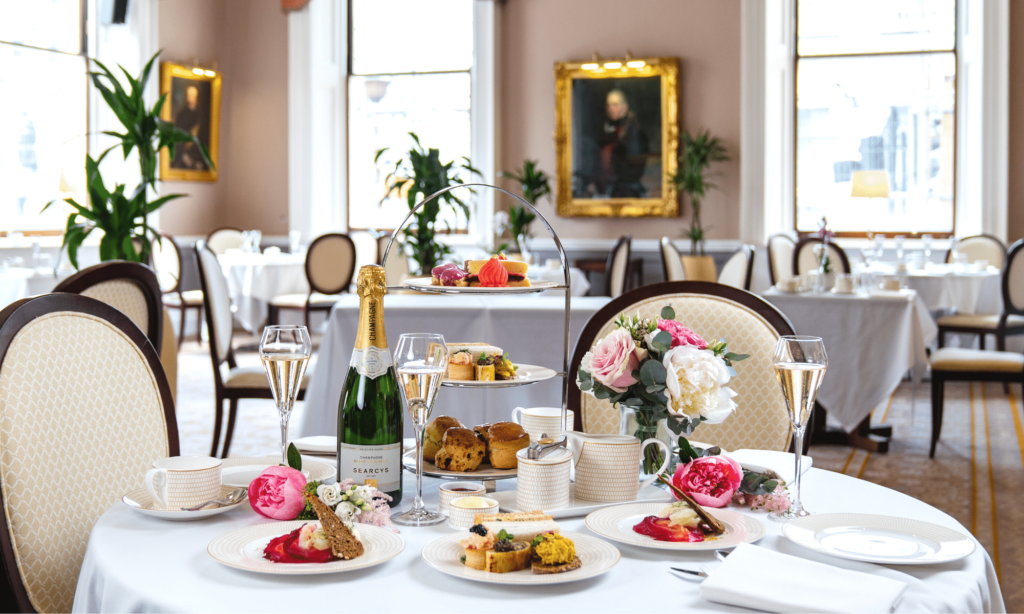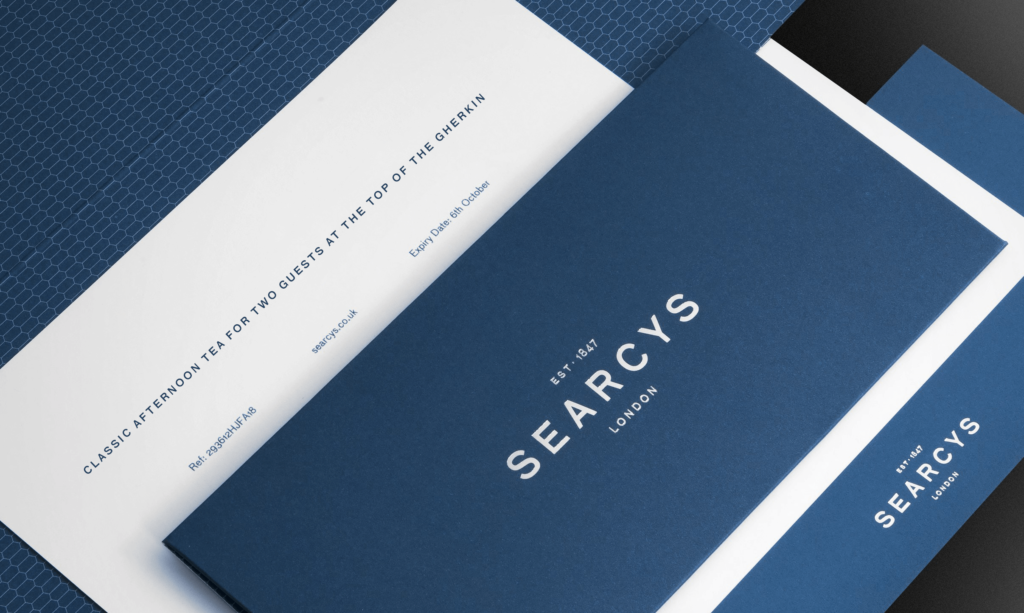-
A Friday Chat with Afternoon Tea Expert, Gillian Walnes Perry MBE
12 August 2022
Afternoon tea is a quintessentially British ritual, an elegant affair best enjoyed with dainty finger sandwiches, scones, and loose-leaf tea. But did you know it can be traced back to the 1840s, when the Duchess of Bedford asked her servant to bring her something to tide her over until dinnertime? In celebration of Afternoon Tea Week – taking place from 8 – 14 August – we talk to lecturer, author, and Afternoon Tea specialist Gillian Walnes Perry. Gillian will be hosting a one-off talk on the social history of English afternoon tea at 116 Pall Mall on Sunday, 14 August, accompanied by a glass of champagne and a lavish afternoon tea, naturally. The event can be booked here [https://www.116pallmall.com/afternoon-tea] and is sure to be one to remember.
Hi Gillian! Thanks so much for speaking with us. Could you start by telling us a bit about the event you will be hosting?

We’ll all tuck into Searcys’ delectable afternoon tea, complete with its own Champagne. After this, I’ll give a little talk, along with a richly illustrated slide show, about how we started drinking tea as a nation, the legend attached to that, and how enjoying afternoon tea became fashionable through Europe. We all know and love afternoon tea as a part of traditional English culture, but there are so many wonderful and unexpected stories that I’m looking forward to sharing with the audience.
Tell us a bit about the 200-year history of afternoon tea, and why it’s so quintessentially linked to British culture.
Even though it’s popular all over the world, and there are all sorts of variations worldwide, it is deeply rooted here and very much thought of as English and something visitors to the UK really want to experience.
What are a couple of facts you might not know about afternoon tea?
The terms “high tea” and “low tea” were developed in the industrial revolution and mean quite the opposite to what you might imagine. High tea was in fact, not associated with the Queen or aristocracy but the working class, who went home for their tea at 5 or 6 after a hard day’s work. It usually contained meat or cheese and was their substantial evening meal. Low tea, on the other hand, was taken at around 4 o’clock at low tables (what we’d now call coffee tables), and was a lighter snack enjoyed by the upper echelons of society to fill the mid-afternoon hunger gap.
The “milk on tea” versus “tea on milk” debate may seem trivial, but it’s divided opinion for centuries. Historically, teacups were often made from poor quality porcelain, which could crack or stain easily if boiling tea was poured in, so it became customary to pour a little milk into the cup first. As fine bone china was developed, pouring your tea in first became ‘proof’ of owning expensive china, so it became shrouded in snobbery, immortalised by British author Evelyn Waugh. Fortnum & Mason have assured me that both ways are totally correct, although the tea takes on a richer and creamier taste if you pour the milk first.
And how about the history of afternoon tea from a societal point of view?
The Duchess of Bedford was the person who had the idea for Afternoon Tea and popularised it among her friends. One of those friends was Queen Victoria, who brought it into court, and the rest is history. It was always (remove always) seen as a women’s social activity when the men were out at work. As public tea rooms started opening up, women used them as a place they could go out and feel comfortable mingling socially with their friends. You can even say that it was during these afternoon teas that the emancipation movement really took hold between circles of women.
Why is the ritual of afternoon tea just as important as ever today?
Let’s face it, we don’t go out for afternoon tea every day, so it’s always a special treat and an occasion to look forward to. I also think because we associate it with birthday parties we went to as children, where we’d eat jelly and ice cream and bowls of crisps, it’s got that celebratory feel. I dedicated my book ‘Please pass the scones’ to my four grandchildren in the hope that they’ll grow up loving afternoon tea as much as we do, as a tradition that will continue to be treasured.
Describe your ideal afternoon tea menu to us.
Well, of course, there must be dainty sandwiches with smoked salmon and cucumber, or some unusual but delicate savouries, nothing too bulky. Scones should not be too huge, fresh from the oven, with a sharp jam like a blackcurrant or a raspberry rather than anything too sweet. And then one small patisserie item to finish off, but not too many. Tea should be poured from a pot with a tea strainer. And the tea items simply must be served on a three-tier cake stand.
Tea or champagne? Which do you prefer?
Tea. It’s also wonderful to have champagne with afternoon tea as a precursor to the main event, perhaps a glass of fizz as the guests arrive to encourage mingling, and then a beautiful range of teas served at the table. Never coffee!
Finally, with 175 years of history, Searcys is almost as old as the tradition of afternoon tea itself. What are your wishes for Searcys as we look ahead to the future?
Much in the way that John Searcy and his sons spotted future trends and evolved their offering to suit this back in the 19th century, a business that survives 175 years is definitely doing something right. I think a company that carries the name of its remarkable creator John Searcy will always move with the times (for example, I notice how active Searcys are on social media), but keep the traditional legacy going too. We all owe it to John Searcy and what he achieved to make sure we evolve to suit the climate, while never losing sight of the original values he upheld as a kind, honest and hard-working man.
Gillian Walnes Perry MBE See: gillianwalnesperry.com
‘Please pass the scones, a social history of English afternoon tea’ is available to purchase for £14.99 here.
-
WHAT'S ON
Celebrate Afternoon Tea Week with Searcys
 BOOK NOW
BOOK NOWTHE SOCIAL HISTORY OF ENGLISH AFTERNOON TEA TALK
Celebrate Afternoon Tea Week at 116 Pall Mall as we are joined by Gillian Walnes Perry MBE, to discuss the history and etiquette of Afternoon Tea. This exclusive Afternoon Tea Week experience is accompanied with our Confectioners Afternoon Tea and a tour of the magnificent 116 Pall Mall. Available Sunday August 14th and 21st. 116 Pall Mall
 BOOK NOW
BOOK NOWAFTERNOON TEA BY SEARCYS
Celebrate AfternoonTea Week with Searcys. Join us at one of our iconic locations and treat yourself to our scrumptious selection of scones, sweet treats and plenty of fizz.
 SHOP NOW
SHOP NOWSHOP SEARCYS GIFT VOUCHERS
There's always an occasion for Afternoon Tea. Treat someone special to a Searcys Afternoon Tea at a time that suits you.
-
- ABOUT SEARCYS
- Restaurants and Bars
- Event Venues
- EVENT SPACES
- All Locations
- {10-11} Carlton House Terrace
- 30 Euston Square
- 41 Portland Place
- 116 Pall Mall
- Barber-Surgeons Hall
- Battersea Power Station
- Carpenters’ Hall
- Church House
- Gray’s Inn
- Horizon 22
- IET London: Savoy Place
- National Army Museum
- No. 11 Cavendish Square
- One Moorgate Place
- Saddlers’ Hall
- Searcys at The Gherkin
- EVENT SPACES cont.
- Event Types
- SEARCYS IN THE CITY
- SEARCYS ROLLS-ROYCE
- Let Us Find Your Venue
- Event Catering
- What’s On
- Contact Us
- ABOUT SEARCYS
- Restaurants and Bars
- Event Venues
- EVENT SPACES
- All Locations
- {10-11} Carlton House Terrace
- 30 Euston Square
- 41 Portland Place
- 116 Pall Mall
- Barber-Surgeons Hall
- Battersea Power Station
- Carpenters’ Hall
- Church House
- Gray’s Inn
- Horizon 22
- IET London: Savoy Place
- National Army Museum
- No. 11 Cavendish Square
- One Moorgate Place
- Saddlers’ Hall
- Searcys at The Gherkin
- EVENT SPACES cont.
- Event Types
- SEARCYS IN THE CITY
- SEARCYS ROLLS-ROYCE
- Let Us Find Your Venue
- Event Catering
- What’s On
- Contact Us
Saved Venues0Stay Connected with Searcys
Sign up to receive updates on exclusive events, restaurant offers, and more from Searcys.
- Restaurants and Bars
- Restaurants and Bars



